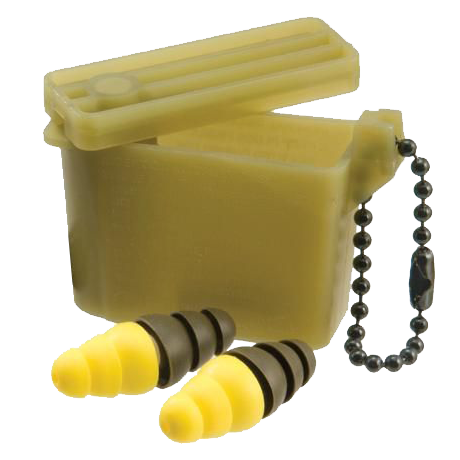Written by Katie Hanna
An Effort To Combat Hearing Loss in Armed Service Men & Women
The 3M Company, formerly known as the Minnesota Mining and Manufacturing Company, is an American multinational conglomerate corporation operating in the worker safety, health care, and consumer goods industries.
From 2003 to 2015 3M was in contract with certain legs of the United States military to provide, as standard issue, safety ear plugs to service men and women. The Combat Arms Earplugs, Version 2 (CAEv2) are dual-ended, one end yellow and the other dark green or black. Their intention was to offer the wearer the ability to hear low-level communications while simultaneously blocking high-impulse noise when the yellow end was inserted. When the dark end was inserted, the intention was to block all sound including voices.
Hearing Loss in Armed Service Men and Women
Hearing impairments are the most common service-related disabilities reported by the United States military veterans. According to the Center for Disease Control and Prevention (CDC), veterans are 30 percent more likely to experience severe hearing impairment (SHI) than non-veterans.
It is worth noting that the CDC also stated that veterans who served in the United States military during September 2001 through March 2010, the era of overseas operations (including Operations Enduring Freedom and Iraqi Freedom), were four times more likely than non-veterans to have SHI. This time period is concurrent with the time period in which 3M was supplying the U.S. military with the CAEv2 earplugs.
The American Journal of Epidemiology conducted a review of 13 studies related to the prevalence of hearing loss and tinnitus and 4 studies related to risks and protective factors. They concluded that individuals that serviced during Operations Enduring Freedom, Iraqi Freedom, and New Dawn will have a greater likelihood of experiencing hearing health issues than those that served in prior years. They conjectured that this is most likely related to the fact that approximately 75% of the service member combat injuries during this time period were a result of blasts which have a high propensity of causing hearing damage.
In 2016, a study published by RadioGraphics described injuries that can occur after a person is exposed to a blast from an improvised explosive device (IED). It states the multiple types of physical trauma that can occur after exposure to an IED but emphasizes that primary injuries are a result of the high-pressure blast wave and the subsequent drop in pressure after the blast wave. This combination causes compression and shearing of tissues as the wave passes through the body and results in injuries to gas-filled structures such as the ear.

The Lawsuit & Resulting Settlement
Unfortunately, claims arose that the earplugs supplied by 3M were defective. It was reported that the portion made to fit inside the ear canal was not long enough. The earplug would eventually loosen unexpectedly allowing loud noises to enter the ear canal. Repeat exposure is of course known to cause hearing loss and tinnitus.
Back in 2012, 3M issued a press release discussing their contract with the U.S. Military to provide these noise-canceling devices to service men and women. They spoke about the importance of proper protection against hearing loss, stating, “Military personnel are exposed to excessive noise levels during combat and training,” and that ”This noise exposure has led many personnel to experience hearing loss and tinnitus, which is currently the number-one service-related disability for veterans.”
They concluded by stating, “We look forward to [equipping] the U.S. Armed Forces with devices that allow them to hear mission-critical communication while helping reduce the risk of developing tinnitus and noise-induced hearing loss.” Though it appears their commitment fell short.
In May 2016, a coordinated effort was made by the Civil Division of the Department of Justice and the United States Attorney’s Office for the District of South Carolina, with support from the Department of Defense to file a petition against 3M under the whistleblower provisions of the False Claims Act.
The suit alleges that 3M and its predecessor (Aearo Technologies, Inc) knowingly sold the dual-ended combat arms earplugs to the Defense Logistics Agency without disclosing defects that hampered their effectiveness. Furthermore, they state this directly impacted service members and exposed millions to potential hearing loss and tinnitus.
The qui tam relator appointed to represent the whistleblower stated that 3M and its predecessor had knowledge of the design defect going back as far as 2000 and that the earplugs failed to produce any noise-reduction benefit. The whistleblower also stated that the yellow fins on the earplug prevented it from forming a tight seal in the wearer’s ear canal unless they were folded back.
In its response, 3M admitted that Aero had tested the earplugs in 2000 and that the test came back with a noise reduction rating (NRR) of 0, submitting that the results did, in fact, indicate that the earplugs had no noise reduction benefits.
In July 2018, a settlement was reached by both parties and 3M agreed to pay $9.1 million dollars in damages to the United States government and have discontinued the CAEv2 earplugs. While this has not resulted in a class-action lawsuit, all sources seem to indicate that this may not be the end of legal fallout for 3M regarding the defective earplugs.
If you are a current or former military service member who served any time from 2003 to 2015 and suffered hearing loss or tinnitus, you may be entitled to compensation from 3M.
Sources:
United States ex rel. Moldex-Metric v. 3M Company, Case No. 3:16-cv-1533-MBS.(2016). Retrieved from https://wwwcache.wral.com/asset/news/local/2019/01/22/18141196/15356-3M_Earplug_Complaint-DMID1-5hka47ucb.pdf
U.S. Department of Justice. (2011). The False Claims Act: A Primer. Retrieved from https://www.justice.gov/sites/default/files/civil/legacy/2011/04/22/C-FRAUDS_FCA_Primer.pdf
U.S. Department of Justice. (2018). 3M Company Agrees to Pay $9.1 Million to Resolve Allegations That it Supplied the United States With Defective Dual-Ended Combat Arms Earplugs. Retrieved from https://www.justice.gov/opa/pr/3m-company-agrees-pay-91-million-resolve-allegations-it-supplied-united-states-defective-dual
Singh, A.K., Ditkofsky, N.G., York, J.D. et al, Blast injuries: from improvised explosive device blasts to the Boston Marathon bombing. Radiographics. 2016;36:295–307.

Katie Terrell Hanna
Katie Terrell Hanna is a professional freelance writer and consultant. She developed an interest in litigation journalism after an internship at the Office of State Attorney in the 15th Judicial Circuit of Palm Beach County, Florida. She is also a graduate of the Center for Pre-Law/Law Related Careers at the Gerald A. Williams Center for Pre-Law in West Palm Beach, Florida and was inducted into the Law Honor Society of her graduating class.

Compensation is Available for 3M Military Earplugs Lawsuits
If you or a loved one served in the military from 2003 – 2015 and experienced any hearing damage after using 3M Combat Arms Earplugs, you may be able to submit a legal claim.


